Spectacular Capri – Southern Italy’s Isola Bella

Lying at the southern edge of the Bay of Naples, beyond the Sorrentine peninsula, the rocky island of Capri has been renowned as a holiday destination for about two thousand years. It’s an island of myths, Roman emperors and their infamous orgies, luxury yachts and the occasional A-list celebrity, but above all, the most spectacular vistas imaginable.
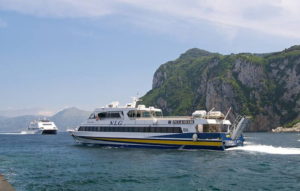
Unless you take a private helicopter transfer, the only way to get to Capri is by boat. Regular ferries ply back and forth from Naples and Sorrento as well as additional seasonal ferry services from the Amalfi Coast, calling at Positano and Amalfi. As the ferry nears the port of Marina Grande, there’s a palpable frisson among the passengers as everyone cranes their neck to catch a glimpse of the island’s iconic towering cliffs rising out of the Tyrrhenian sea.
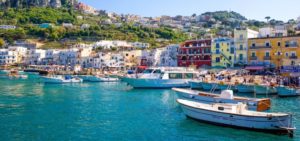
There’s a direct shuttle bus service, called the Alibus, from Naples Capodichino Airport via the main railway station down to the ferry port of Molo Beverello—the crossing takes around 40 mins. by hydrofoil and a little longer by regular ferry. From Sorrento, take either the shuttle buses that run from Piazza Tasso, or the elevator from the Villa Comunale down to the port for the 25 min. trip.
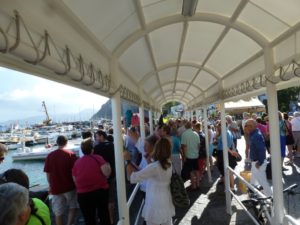
The comings and goings at Marina Grande seem like total chaos. Passenger ferries, hydrofoils, large car ferries and private vessels disgorge capacity crowds back and forth every day. As well, there are the dozens of small, local fishing boats tightly packed along the waterfront. Porters from the numerous hotels push their hand carts, loaded to the hilt with guests’ luggage, onto the ferries as soon as the incoming passengers and their luggage stagger off, and somehow, it all works. If you don’t fancy lugging your bags with you up to your hotel, there are porters who will deliver them for a fee per item.
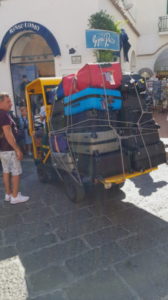
There’s a transport kiosk as you come ashore that sells the ticket for the funicular, but a warning: there are quite a lot of steps at the top which is quite a challenge with luggage in tow. There are also taxis as well as buses that travel busily around the island, but there are no private vehicles in Capri itself, nor can taxis take you to the hotels in the town. Electric carts are allowed for carrying goods only. There are some private vehicles on the other side of the island, at Anacapri.
The island is explored almost entirely on foot, although buses run between the two towns, down to the port and the Marina Piccola, a tiny, pebbled beach. One of the joys of the island is the wonderful walks that take in so many of the island’s attractions—indeed some pathways are quite challenging and better qualify as hiking trails. It’s easy to feel almost overwhelmed by the sheer beauty of the place and the countless breathtaking panoramas at every turn.
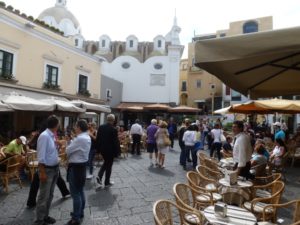
The town of Capri is a delight to explore with quaint alleys and narrow, pedestrianised streets and small piazzas. At the town’s centre is La Piazzetta, the heart and soul of Capri that still epitomises the idea of the Italian hedonistic lifestyle, la dolce vita.
The Piazzetta’s numerous cafes and restaurants are filled with locals and visitors, often including holidaying celebrities, all relaxing and people-watching, although it must be said that one of the favourite pastimes would have to be shopping!
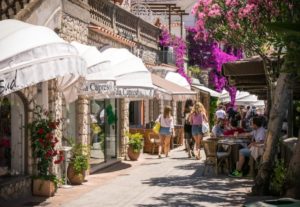
Capri and Anacapri are renowned for their small boutiques selling everything from the usual international designer labels to good quality resort-wear created and made locally.
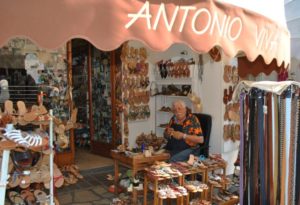
Capri has long been famous for a distinctive, flat leather strappy sandal, and there are little shops making and selling these, such as Antonio Viva at L’Arte del Sandalo Caprese and Canfora, plus a couple of others just off the Piazzetta.
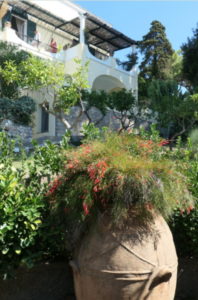
Heading out of town, up one of the steep paths lined with attractive villas and the occasional small hotel, one of the great pleasures is peering over the stone walls to admire lush, private gardens overflowing with luxuriant flowering plants such as brightly coloured bougainvilleas, numerous citrus and olive trees and perhaps a vegetable patch. Outdoor furniture is usually set out invitingly on pretty terraces kept cool by the deep shade provided by vibrant bougainvillea or dense grape vines heavily laden with bunches of grapes, ripe for the picking. The rich, volcanic soil means anything grows with great abundance, and the island’s microclimate supports an astonishing array of flora. Despite the building development over the centuries, there are still holm oak forests and fields of wild orchids.
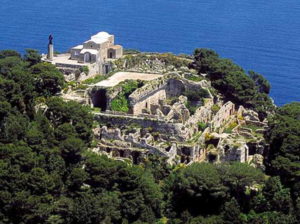
The Romans, with their sybaritic wealth, had the greatest influence in forming the island’s psyche. By the 1st century CE, there were said to be over a dozen imperial villas scattered across Capri, prompting the Emperor Augustus to nickname it ‘Aprogopolis’ (City of Sweet Idleness).
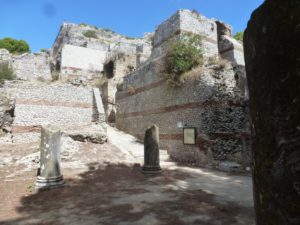
Today, one of the island’s great historic landmarks is the Villa Jovis, the ruins of an extensive Roman villa famously (or infamously!) occupied by the Emperor Tiberius (42 BC – 37 AD), from where he governed, in his increasingly paranoid, depressed state, the entire Roman Empire. The mere mention of Villa Jovis was enough to make respectable Romans blush.
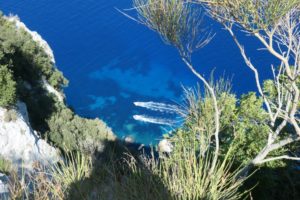
Thanks to the salacious, and probably highly exaggerated reports by Roman writers such as Suetonius, the Villa and its inhabitants became notorious as the epitome of depravities of unimaginable proportions. It was rumoured that Tiberius ordered errant subjects, and those young “companions” who ceased to amuse or please him, be hurled from the cliff-tops. The Villa’s rooms were furnished with the most erotic paintings and sculptures. There was a large library filled with the ancient equivalent of X-rated writings, while the gardens had numerous bowers and grottoes, that according to Suetonius, people openly dubbed “the old goat’s garden”.
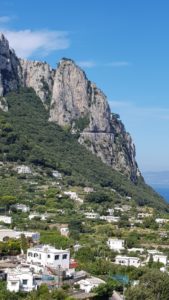
It’s quite a long climb up the steep path out of town, but the spectacular views from the site across to the Amalfi coastline are incredible. Not far from the entrance you’ll find a delightful family-run café with amazing views, the perfect place to relax for a light lunch after tramping all over the Villa’s substantial remains.
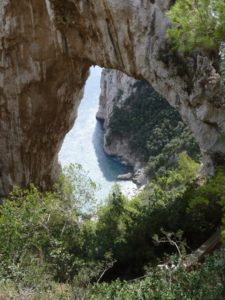
Another walk, about 30 minutes out of Capri’s centre, past all the chi-chi shops, pretty little cafes and following the small signposts, is to the Arco Naturale. This amazing rock formation consists of two pillars 12m wide and about 18m high, and affords heart-stopping views through the arch down a sheer drop to the vivid turquoise waters below.
One of our favourite things to do is take the bus across to Anacapri and hop on the chairlift that goes up to Monte Solaro, the highest peak on the island.
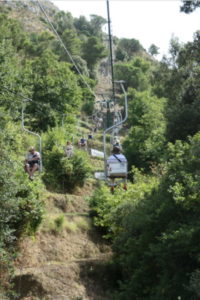
The delightfully peaceful ride skims up over private houses, gardens, orange and olive groves, arriving at the top where there is a terraced café in a garden setting, as well as the statue of the emperor Augustus used in virtually all the island’s tourism promotions, arm outstretched towards infinity, as though to indicate the extent of the Roman empire. The views from here are surely among the most spectacular in Europe.
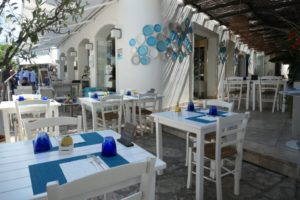
Back down in Anacapri, take a leisurely meander through the charming little shopping streets where you’ll find numerous cafes and tiny piazzas with their majolica tiled benches.
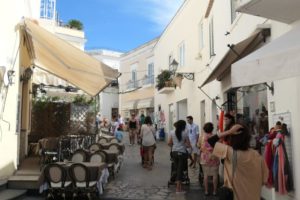
Check out the pretty boutiques filled with delicious local resort-wear in gauzy linens, pottery shops and many outlets selling the local limoncello liqueur. From Piazza Vittoria, the picturesque via Capodimonte leads to one of the loveliest landmarks of the island, the famous Villa San Michele.
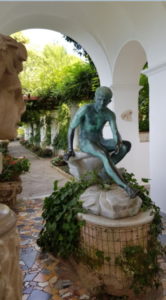
Once the home of Swedish doctor and philanthropist Axel Munthe (1857-1949), the villa houses his eclectic collection of antiquities and artefacts. The house is set around Roman-style courtyards, marble walkways and atria.
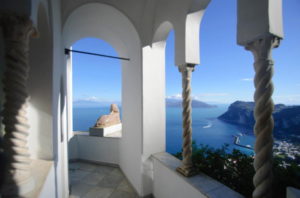
The beautiful garden is filled with flowering shrubs that attract various bird species, a pergola pathway and various statuary, including a small ancient Egyptian sphinx that gazes out to sea, across to the mainland. The small chapel of San Michele sits on the site of one of Tiberius’s villas.
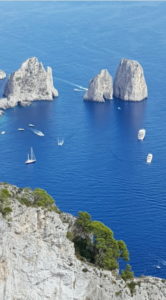
One of the first images to come to mind when you think of Capri must be that of the Faraglioni rocks which rise spectacularly out of the sea, just a few metres from the island’s southern shoreline. These dramatic spurs—the tallest being over 150m high—provide a unique habitat for a rare blue-coloured lizard. One of the rocks is characterised by a central, arched cavity, large enough for small boats to pass through. In ancient times, it’s thought that these rocky “stacks” were used as lighthouses, topped by signal fires that were lit at night to provide safe navigation.
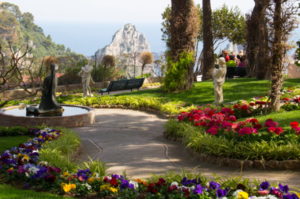
There’s a stunning view of the Faraglionis from the beautiful Giardini di Augusto, a short walk out of Capri town centre.
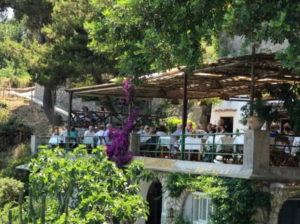
This delightful walk will take you past a couple of small hotels, villas and pretty outdoor cafes. From the flower-decked terraces of the Gardens there’s the awe-inspiring sight of numerous villas perilously clinging to the cliffsides.
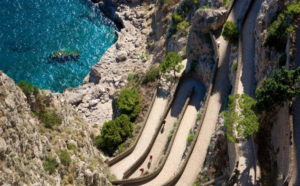
There’s a steep switchback pathway, the via Krupp, that leads down to the water far below—it’s easy to see why this path is sometimes closed due to rock falls off the sheer cliffs.
The other famous Capri attraction of course is the Blue Grotto. The natural cave is 60m long and 25m wide, with the mouth of the cave being around two metres wide but only a metre high.

Entry is only via small rowing boats, and passengers must lie back along the bottom of the boat while the skipper guides you through the opening using a metal chain attached to the cave walls. Visits inside the cave are restricted to 5 minutes, however the wait outside, in a long queue of boats, can be around an hour, so be warned and remember to take a sunhat! It’s best to avoid visiting the grotto on heavily overcast days, since the effect of the sunlight inside is much less dramatic. Tickets just to visit the Blue Grotto can be purchased at Marina Grande, although there’s a bus from the centre of Anacapri. Alternatively, there are boat tours around the island which include the Blue Grotto.

So many visitors pop over to Capri just for a day. This is such a shame and a wasted opportunity to experience one of the loveliest resorts in Europe.
At day’s end, after exploring the island’s beautiful walkways, visited some of the fascinating sights, enjoyed a little shopping and been awed by the panoramic views, it’s time for an aperitivo . Just sit back and enjoy the calm of the evening that descends after the last boatload of daytrippers has departed the island.
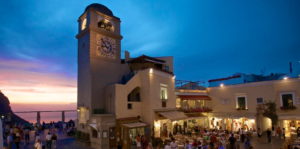


Leave a Reply